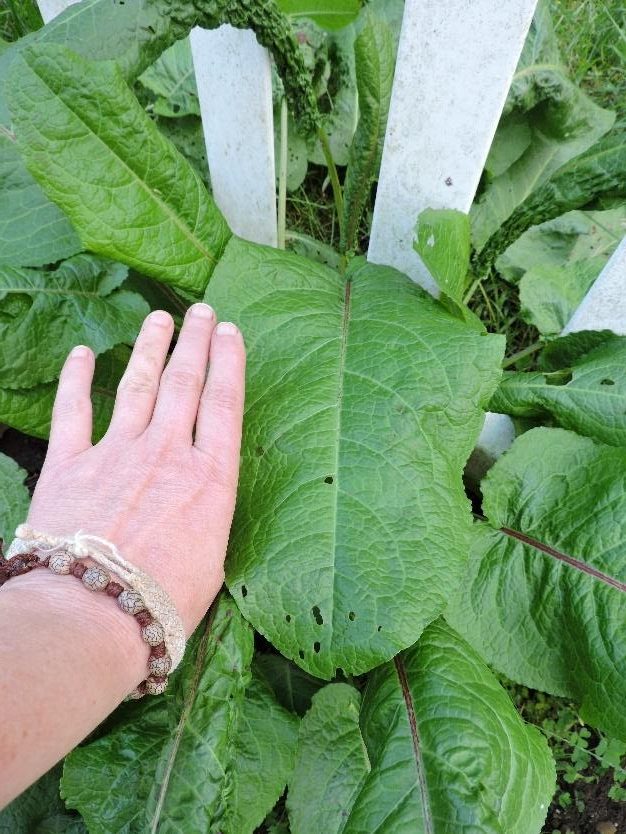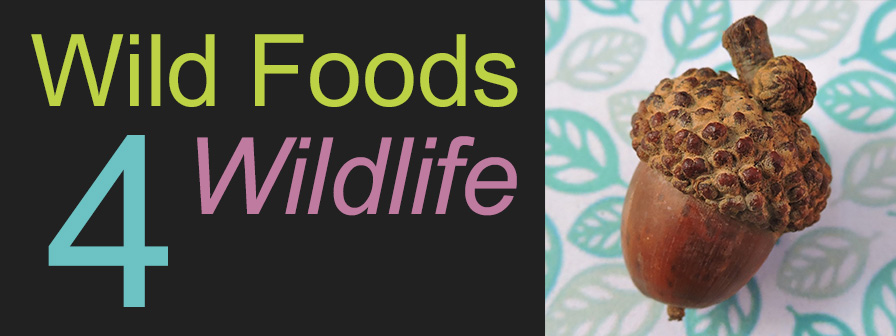Name: Broadleaf Dock
Botanical Name: Rumex obtusifolius
Form: wildflower
Parts Used: seeds, greens
Citation: Guenther, K. (2020, January 12) Broadleaf dock as wildlife food [Web log post.] Retrieved: supply the date, from http://wildfoods4wildlife.com
Getting Started
Also known as bitter dock, broadleaf dock is 19th on our list of Super Seeds, a favorite of eastern towhees. It is a very easy beginner seed to forage because it is easy to identify and the seeds do not need much cleaning, if any. Also, dock leaves are eaten by cottontails and the large leaves mean you can gather a good quantity quickly off just a few plants. You can harvest some leaves then come back and cut more later in the season as the plant continues to grow. And next year!
The main drawback of dock is that it is high in soluble oxalic acids, so it should not be fed in too high a quantity, more as a garnish. That, plus it can be very hard to remove from a garden once it is established.
Polygonaceae (Buckwheat Family)
Rumex (Genus)
| Common name | Virginia Rumex Species | Origin | Rare Plant Status |
| Sheep sorrel | R. acetosella | non-native | Not rare |
| Pale dock | R. altissimus | native | Yes, in some states (not Virginia) |
| Clustered dock | R. conglomerates | non-native | Not rare |
| Curly dock | R. crispus | non-native | Not rare |
| Heart-wing sorrel | R. hastatulus | native | Yes, in some states (not Virginia) |
| Broadleaf dock | R. obtusifolius | non-native | Not rare |
| Fiddle dock | R. pulcher | non-native | Not rare |
| Swamp dock | R. verticillatus | native | Yes, in some states (not Virginia) |
Virginia Botanical Associates. (Accessed January 2020). Digital Atlas of the Virginia Flora (http://www.vaplantatlas.org). c/o Virginia Botanical Associates, Blacksburg.
USDA, NRCS. 2015. The PLANTS Database (http://plants.usda.gov, 31 January 2020). National Plant Data Team, Greensboro, NC 27401-4901 USA.


One growing in dry soil, another right in a stream.
Key Features to Look For
In addition to the identification guide of your choice, here are a couple of features you should see on this plant:
- Generally, a 3-foot tall plant at maturity
- Stem is oval to round in cross-section and ridges that run the length of the stem
- Stem has a small hollow center
- Seed are in clusters up the branchlets
- The seeds are shaped like small roundish footballs and have 3 papery wings lengthwise symmetrically. Each seed has a short stem (petiole) about the same length as the seed itself
- Seeds turn a burnt sienna color when mature
- Leaves emerge out of a rosette at the ground, and are large
- Leaf shape is a long oval, up to 30 inches long
- Cut in cross-section, the leaf stem is round, with one flat edge


Risks
Rumex spp. are high in a chemical constituent called oxalic acid.
Medical toxicologist, Sandra James-Yi, DVM, PhD, DABT, explained to me that “all plants contain oxalic acid— so the issue becomes one of quantity.” Soluble oxalic acid is present in a number of common foods animals and people eat. When digested, the oxalic acid enters the bloodstream. If the level of soluble oxalates in the blood is high, the acids can precipitate out of the blood by binding with calcium, and cause hypocalcemia, or low levels of calcium in the plasma. Ingested in large quantities over a long period, soluble oxalates can damage the kidneys. In extreme cases, it can be fatal. So soluble oxalate toxicity is generally one of quantity.”
It’s best to think of plants like dock with these oxalates as a treat or garnish, and offer them to your patients within an array of healthy food choices. And check with your veterinarian in any case where calcium issues are a large part of the patient management.
About This Species
Dock is in the Buckwheat family, which also includes some perennial gardening plants such as sheep sorrel, garden sorrel and French sorrel.
Flower Description: Flowers are very small and difficult to see, but multiple white petals cluster within the sepals.

Leaf Description: Leaves are broad and heart-shaped at the base with a groove that runs the length of the leaf stem on the underside. Stems and leaf edges may be tinged with red. In early spring, collect greens before the plant grows and flowers, when they are tastiest and least fibrous and bitter. The leaves are basal—they all emerge from a center point in the ground—and the leaf edges (margins) are smooth (no teeth). Leaves are somewhat shiny.



Seed Size: Dock seeds are egg shaped with 3 paper wings attached perpendicularly to the seeds.


Harvesting
| Jan | Feb | Mar | Apr | May | Jun | Jul | Aug | Sep | Oct | Nov | Dec | ||||||||||||||
|---|---|---|---|---|---|---|---|---|---|---|---|---|---|---|---|---|---|---|---|---|---|---|---|---|---|
| winter | winter | late winter | early spring | spring | late spring | early summer | summer | late summer | early fall | fall | late fall | ||||||||||||||
| seeds | x | x | x | ||||||||||||||||||||||
| greens | x | x | x | x | x | x | |||||||||||||||||||
Does this lend itself as a good enrichment item?
Yes, for seeds. The best stalks to harvest for enrichment will have red-brown seeds but the stalks and leaves will still be very slightly green. If you wait longer than that and the leaves or stems are totally brown, the seeds will be very easy—too easy—to dislodge from the stem to be used for enrichment. But those loose seeds can still be offered as food. Stems are sturdy and can be cut and installed inside an enclosure for animals to glean the seeds off the stalks themselves. With care, stalks loaded with seed can be harvested and keep upright in a bucket without losing too many seeds in transport.

Harvesting Dock Seed:
You can harvest stalks for seed anytime the seeds are fully chestnut brown color. By the time the leaves and stems turn fully brown, the seed will be starting to fall off the stalks readily.
When harvesting for seed, I like to clip off the leaves, which are few, right in the field as I cut the stalk. Removing the leaves means now when you remove the seeds from the stem after the seeds have dried and cured, there will be less leaf debris to sift out, making for cleaner seed and less work.
You can easily pull the mature seeds off the stems by running the stalks through your hands. Work over a large paper sack or a sheet to collect the seeds.
It is easy to collect a large quantity of dock seed, even with just a handful of plants.
Harvesting Dock Greens:
Green leaves can be harvested at anytime spring to fall, but are tastier and less fibrous when young and small in early spring, before the plant sends up its main stem. Wash and refrigerate as soon as possible after harvest.

Other Species:
An extremely similar plant, curly dock (Rumex crispus), is another common, introduced dock that grows in the same habitat as broadleaf dock. For our purposes, I’m not sure there is any reason to differentiate the two species, and I don’t know if animals have a preference. However, if you are inclined to figure it out exactly which species you have, leaf width is the key. Broadleaf dock’s leaves are more oval and longer, up to about 30 inches long and the edges of the leaves lay fairly flat. Curley dock’s leaves are more spear-shaped, about 20 inches long and the edges of the leaves curve up to form ruffled edge.

Rare Species in Virginia:
None in Virginia.
Feed Dock to:
dock | (Rumex spp.) | greens |
|---|---|---|
 Caution: Greens of some Rumex spp. eaten in large quantities have caused sheep poisonings from insoluble oxalate crystals and/or accumulated nitrates. Leaves can also can cause contact dermatitis in humans.(Canadian Biodiversity Information Facility, 2013; Douglas, 2004) | ||
Cottontail, Eastern | Sylvilagus floridanus |
|
Elk, Rocky Mountain | Cervus elaphus |
|
Mouse, Common White-footed | Peromyscus leucopus |
|
Vole, Meadow | Microtus pennsylvanicus |
|
Vole, Pine | Microtus pinetorum |
|
Voles, various spp. | various species |
|
Bobwhite, Northern | Colinus virginianus |
|
Grouse, Ruffed | Bonasa umbellus |
|
Pheasant, Ring-necked | Phasianus colchicus |
|
Turkey, Wild | Meleagris gallopavo |
|
dock | (Rumex spp.) | seeds |
 Caution: Leaves can cause contact dermatitis in humans.(Douglas, 2004) | ||
Mouse, Common White-footed | Peromyscus leucopus |
|
Vole, Meadow | Microtus pennsylvanicus |
|
Vole, Pine | Microtus pinetorum |
|
Voles, various spp. | various species |
|
Towhee, Eastern | Pipilo erythrophthalmus | strong preference |
Blackbird, Red-winged | Agelaius phoeniceus |
|
Bobolink | Dolichonyx oryzivorus |
|
Bunting, Snow | Plectrophenax nivalis |
|
Cowbird, Brown-headed | Molothrus ater |
|
Finch, House | Carpodacus mexicanus |
|
Grosbeak, Evening | Coccothraustes vespertinus |
|
Lark, Horned | Eremophila alpestris |
|
Nuthatch, Red-breasted | Sitta canadensis |
|
Pipit, American | Anthus rubescens |
|
Sparrow, American Tree | Spizella arborea |
|
Sparrow, Field | Spizella pusilla |
|
Sparrow, Fox | Passerella iliaca |
|
Sparrow, Grasshopper | Ammodramus savannarum |
|
Sparrow, Henslow's | Ammodramus henslowii |
|
Sparrow, Lincoln's | Melospiza lincolnii |
|
Sparrow, Song | Melospiza melodia |
|
Sparrow, Swamp | Melospiza georgiana |
|
Sparrow, Vesper | Pooecetes gramineus |
|
Sparrow, White-crowned | Zonotrichia leucophrys |
|
Sparrow, White-throated | Zonotrichia albicollis |
|
Bobwhite, Northern | Colinus virginianus |
|
Grouse, Ruffed | Bonasa umbellus |
|
Grouse, Sharp-tailed | Tympanuchus phasianellus |
|
Pheasant, Ring-necked | Phasianus colchicus |
|
Turkey, Wild | Meleagris gallopavo |
|
Book References
Elpel, T.J. (2013) Botany in a Day (APG). Pony, Montana: Hops Press, LLC.
Martin, A.C., Zim, H.S., Nelson, A.L. (1951). American Wildlife and Plants: A Guide to Wildlife Food Habits. New York: Dover Publications.
Scott, M. (2013). Songbird Diet Index. National Wildlife Rehabilitators Association, St. Cloud, MN.
Townsend, J. F. (2015, April) Rare Plants Natural Heritage Technical Report 15-10. (Unpublished Report) Richmond, Virginia: Virginia Department of Conservation and Recreation, Division of Natural Heritage.
Online References
USDA, NRCS. 2015. The PLANTS Database (http://plants.usda.gov, 15 February 2020). National Plant Data Team, Greensboro, NC 27401-4901 USA.
Virginia Botanical Associates. (Accessed January 2016). Digital Atlas of the Virginia Flora (http://www.vaplantatlas.org). c/o Virginia Botanical Associates, Blacksburg.
Personal Communication
James-Yi, S. DVM, PhD, DABT, DABT. (2017, September) Personal interview with medical toxicologist at NOW Foods.

